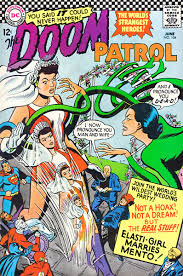Doom Patrol
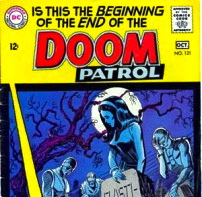
Doom Patrol
I cut this together using footage from the TEEN TITANS episode “Homecoming”. I wanted to see what it would be like if the Doom patrol had their own show so I cut it as a mini adventure… Andy Baird
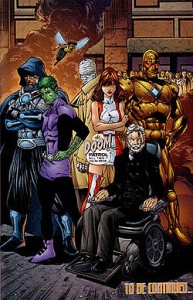 The Doom Patrol. (From left to right: Vox, Beast Boy,Bumblebee (flying), Negative Man, Elasti-Girl, The Chief (seated), Robotman) from Teen Titans vol. 3, #35 (June 2006). Art by Tony Daniel.
The Doom Patrol. (From left to right: Vox, Beast Boy,Bumblebee (flying), Negative Man, Elasti-Girl, The Chief (seated), Robotman) from Teen Titans vol. 3, #35 (June 2006). Art by Tony Daniel.
The Doom Patrol is a superhero team appearing in publications from DC Comics. The original Doom Patrol first appeared in My Greatest Adventure #80 (June 1963). Writers Arnold Drake (who was the feature’s regular scripter) and Bob Haney, artist Bruno Premiani, and editor Murray Boltinoff are generally credited as the team’s creators; however, Drake insisted that Haney did no more than answer Drake’s call for help to meet the short deadline he had been given for the first story. The Doom Patrol has since appeared in multiple incarnations.
The first Doom Patrol consisted of super-powered misfits, whose “gifts” caused them alienation and trauma. The series was canceled in 1968, and Drake killed the team off in the final issue, Doom Patrol #121 (September–October 1968).
In the years after this story several subsequent Doom Patrol series were launched. Each series tried to capture the spirit of the original team, but the only character constant to all was Robotman.
Publication history – The original Doom Patrol (vol. 1)
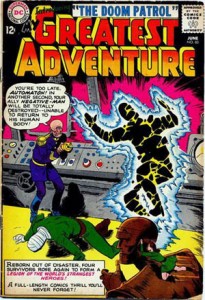 Cover to My Greatest Adventure #80 (June 1963), the first appearance of the Doom Patrol. Art by Bruno Premiani.
Cover to My Greatest Adventure #80 (June 1963), the first appearance of the Doom Patrol. Art by Bruno Premiani.
The Doom Patrol first appeared in 1963, when the DC title My Greatest Adventure, an adventure anthology title, was being converted to a superhero format. The task assigned writer Arnold Drake was to create a team that fit both formats. With fellow writer Bob Haney and artist Bruno Premiani, he created the Doom Patrol, a team of super-powered misfits regarded as freaks by the world at large. It first appeared in My Greatest Adventure #80, June 1963. Doctor Niles Caulder motivated the original Doom Patrol, bitter from being isolated from the world, to use their powers for the greater good. The series was such a success that My Greatest Adventure was officially retitled The Doom Patrol beginning with issue #86.
The Doom Patrol’s rogues gallery matched the strange, weird tone of the series. Villains included the immortality-seeking General Immortus, the shapeshifting Animal-Vegetable-Mineral Man, and the Brotherhood of Evil led by the Brain, an actual brain kept alive by technology. The Brotherhood of Evil also included the intelligent gorilla Monsieur Mallah and Madame Rouge, who was given powers similar to those of Elongated Man, with the extra attribute of a malleable face, allowing her to impersonate various people.
 Cover to Doom Patrol#121 (September–October 1968), the last original issue of the series. Art by Joe Orlando.
Cover to Doom Patrol#121 (September–October 1968), the last original issue of the series. Art by Joe Orlando.
The Doom Patrol had two crossovers: one with the Challengers of the Unknown, teaming up to fight Multi-Man and Multi-Woman; and second with the Flash in Brave and Bold #65.
When the popularity of the book waned and the publisher canceled it, Drake ended the series in a dramatic manner: he killed off the entire Doom Patrol. In Doom Patrol #121 (September–October 1968), the Doom Patrol sacrificed their lives to save the small fishing village of Codsville, Maine. This marked the first time in comic book history that a canceled book ended by having most of its cast of main characters die. Artist Bruno Premiani and editor Murray Boltinoff appeared at the beginning and the end of the story, asking fans to write to DC to resurrect the Doom Patrol, although the latter was supposed to have been Drake. According to the writer, he was replaced with the editor because he had just resigned over a pay dispute and moved to Marvel Comics. He finished the script only out of friendship for Boltinoff. A few years later, three more issues appeared in DC’s short-lived attempt to copy Marvel’s line of series reprint titles (as opposed to DC’s anthology reprint titles). A Doom Patrol revival did not occur until nine years after the original’s demise.
Some similarities exist between the original Doom Patrol and Marvel Comics’ original X-Men. Both include misfit superheroes shunned by society and both are led by men of preternatural intelligence confined to wheelchairs. These similarities ultimately led series writer Arnold Drake to argue that the concept of the X-Men must have been based on the Doom Patrol.
Drake stated:
| “…I’ve become more and more convinced that [Stan Lee] knowingly stole The X-Men from The Doom Patrol. Over the years I learned that an awful lot of writers and artists were working surreptitiously between [Marvel and DC]. Therefore from when I first brought the idea into [DC editor] Murray Boltinoff’s office, it would’ve been easy for someone to walk over and hear that [I was] working on a story about a bunch of reluctant superheroes who are led by a man in a wheelchair. So over the years I began to feel that Stan had more lead time than I realized. He may well have had four, five or even six months.” |
(X-Men #1 debuted three months after MGA #80; due to publication lag times, Lee could not have known of the Doom Patrol when he scripted the first X-Men story unless he had been told about it in advance of its publication.)
However, others have noted that the Doom Patrol shares fundamental similarities with Stan Lee’s earlier title, Fantastic Four. The original lineup of both teams included four members, who did not have secret/double identities; each had a headquarters that was a public building in the middle of a major city; each team had one member with stretching powers (Rita Farr of the Doom Patrol, Reed Richards of the Fantastic Four), one member with flame or flame-like powers (Larry Trainor of the DP and Johnny Storm of the FF), a member with brute strength and a freakish body, with bitterness at being trapped in it (Cliff Steele and Ben Grimm) and a member who was invisible or stayed out of the public view (Niles Caulder and Sue Storm). Both teams quarreled amongst themselves, unlike most other teams published by DC/National.
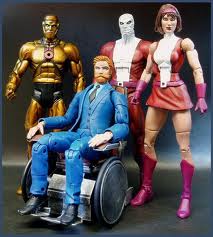 Paul Kupperberg’s Doom Patrol – Testing the waters
Paul Kupperberg’s Doom Patrol – Testing the waters
Writer Paul Kupperberg, a longtime Doom Patrol fan, and artist Joe Staton introduced a new team in Showcase #94 (August–September 1977).
An Indian-born woman named Arani Desai, called herself Celsius because of her ability to stimulate her inner core temperature and project powerful thermal blasts of heat and cold in balance with her formidable martial artist skills, as taught to her by monks high in the Himalayas. Niles had hidden her there, for her own protection. Arani had married Niles in India and when she found out he was murdered she laid claim to his estate in the USA; she recreated the Doom Patrol to protect herself from General Immortus who wanted to rejuvenate himself with the immortality Arani possessed as a wedding gift from Niles.
This run also revealed the whereabouts of the Negative Spirit, which now possessed Russian cosmonaut Valentina Vostok, making her Negative Woman (although its presence did not render her radioactive), and she was able to transform her own body into its form rather than sending it out under control.
It also revealed Robotman as the only survivor of the explosion that killed his teammates, his head, upper torso, and one arm being left in one piece that could keep his brain alive and allow him to drag himself to shore. A man standing on that beach (appearing and later conceded to be Dr. Will Magnus of Metal Men fame) built him a new, futuristic robot body.
The final member of this team was Tempest aka Joshua Clay, a Vietnam veteran/deserter. Tempest’s power was energy blasts from his hands. In addition to a typical comic book blast effect, Tempest would use the blast to propel himself through the air.
This new version of the team followed its three-issue tryout with a series of guest appearances in various DC titles, such as Superman Family (in a three part arc in the Supergirl feature that was intended for the recently canceled Super-Team Family), DC Comics Presents (teaming up with Superman in a story which revealed that Vostok’s powers had changed to match Larry Trainor’s exactly), and Supergirl. Robotman also appeared as an occasional supporting character in the Marv Wolfman and George Pérez era of Teen Titans, where it was revealed that Changeling, formerly DP associate Beast Boy, had arranged for Dayton Industries technicians to recreate the Caulder body design for Cliff. His first storyline here had him, the Titans and a new Brotherhood of Evil battle Madame Rouge and General Zahl, the murderers of the original Doom Patrol, who die in the battle.
Eclipse Comics also printed a two-issue index (with covers drawn by John Byrne) to the Doom Patrol in 1984, which included all of their appearances from their first to their final appearance before their early 1980s return. Byrne also illustrated Secret Origins Annual #1, published in 1987, which recapped the origins of the two iterations of the Doom Patrol that had existed thus far, as a prelude to the relaunch of their self-titled book.
The relaunch (vol. 2)
DC relaunched Doom Patrol in its own title, cover-dated October 1987. The relaunch, also written by Kupperberg but illustrated by artist Steve Lightle, later replaced by a young Erik Larsen after issue #5, showed a more superheroic version of the Doom Patrol. It included new members who were hired to the team: the magnetically empowered strong-girl Lodestone; Karma (Wayne Hawking), whose psychic power made sure that anyone trying to attack him would wind up falling over themselves; and Scott Fischer, whose body generated phenomenal quantities of heat focused through his hands, requiring him to wear protective gloves at all times. Most were not particularly interested in a heroic life. Lodestone stayed for the sense of security; Karma stayed there because it helped him hide from the law. Only Scott Fischer wanted to be a superhero in the traditional sense, and he was rather naive about the real world. A DC Comics Bonus Book appeared in issue #9 (June 1988). After issue 18 and the events of the Invasion miniseries, Kupperberg left the series. DC Comics gave Grant Morrison the task of writing the book.
Grant Morrison’s Doom Patrol
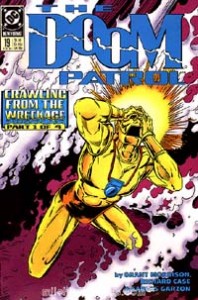 Cover to Doom Patrol vol. 2, #19. Morrison’s first issue. Art by Richard Case.
Cover to Doom Patrol vol. 2, #19. Morrison’s first issue. Art by Richard Case.
After the first 18 issues (and various crossovers and annuals), Kupperberg was replaced by Grant Morrison, starting with issue #19. Kupperberg agreed to help Morrison by writing out characters Morrison did not want to use: Celsius and Scott Fischer died before issue #18—Celsius was killed in an explosion in DC Comics’ “Invasion!” event, and Scott Fischer (already suffering from a recurrence of childhood leukemia) was the only known active superhero casualty of the Dominators‘ gene-bomb (also in “Invasion!”); Karma had left the team as he was still on the run from the law (he would eventually become a member of the Suicide Squad and die on his first mission with them in the “War of the Gods” crossover event); the Negative Spirit left Negative Woman’s body; and Lodestone plunged into a coma, where she would remain for the first half of Morrison’s run on the book. Tempest gave up fieldwork to become the team’s physician. Conversely, Morrison picked up a throw-away character from DP #14, who was slipped into the art on the last page of #18 to set up Morrison’s use: Dorothy Spinner was an ape-faced girl with powerful “imaginary friends.” The new writer introduced some new characters to the team, including the multiple personality-afflicted Crazy Jane; and sentient roadway Danny the Street.
Morrison used DC’s Invasion crossover to restart the book. He took the Doom Patrol, and superhero comic books in general, to places they had rarely been, incorporating bizarre secret societies, elements of Dada, surrealism, and the cut-up technique pioneered by William S. Burroughs and Brion Gysin. He also borrowed the ideas of Jorge Luis Borges and Heinrich Hoffmann. The original creator, Arnold Drake, said Morrison’s was the only subsequent run to reflect the intent of the original series.
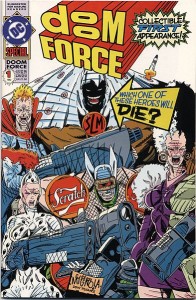 Cover of Doom Forceone-shot, parody of X-Force. Art by Keith Giffen and Mike Mignola.
Cover of Doom Forceone-shot, parody of X-Force. Art by Keith Giffen and Mike Mignola.
Over the course of the series, Morrison dedicated some issues to parody and homage. Willoughby Kipling led the Doom Patrol on a parody of the Brujería story arc of Swamp Thing: A Murder of Crowsin issues #31-32. Issue #42 featured the origin of Flex Mentallo, who was supposed to be the character in the Charles Atlas ad. A belated lawsuit from the Charles Atlas Company showed that DC was protected under pastiche and parody law in addition to an expired statute of limitations. Issue #53 featured a dream sequence that mimicked the Stan Lee/Jack Kirby Fantastic Four, borrowing plot points both from the Galactus Trilogy (FF #48-50) and FF #51, “This Man, This Monster.” Another special called Doom Force was released as a one-shot and was meant to mimic and parody the X-Force book by Rob Liefeld. Issue #45 parodied Marvel’s Punisher in a satire called the Beard Hunter.
Morrison’s approach to the book was also notable in that his villains were extremely unusual and strange, even by Doom Patrol’s eccentric standards. For example:
- Red Jack is a near-omnipotent being who thinks he is both Jack the Ripper and God. He lives in a house without windows, torturing butterflies to create the pain he needs to survive.
- The Brotherhood of Dada are an anarchistic group who fight against reality and reason. It features members such as Sleepwalk, who can only use her tremendous powers when asleep (she takes sleeping pills and listens to Barry Manilow before battles), and The Quiz, who literally has “every superpower you hadn’t thought of” and a pathological fear of dirt.
- The Scissormen, a race of beings that attack non-fictional beings in the “real world” (i.e., the world the Doom Patrol live in) with their large scissor-like hands and literally cut people out of reality.
In Morrison’s final storyline, it is revealed that the Chief had caused the “accidents” which turned Cliff, Larry Trainor, and Rita Farr into freaks with the express intention of creating the Doom Patrol. He then murders Josh and unleashes nanobots into the world, hoping to create a catastrophe that will make the world a stranger and more wonderful place. However, Caulder does not anticipate being decapitated by one of Dorothy’s “imaginary” beings, a malign entity called the Candlemaker.

